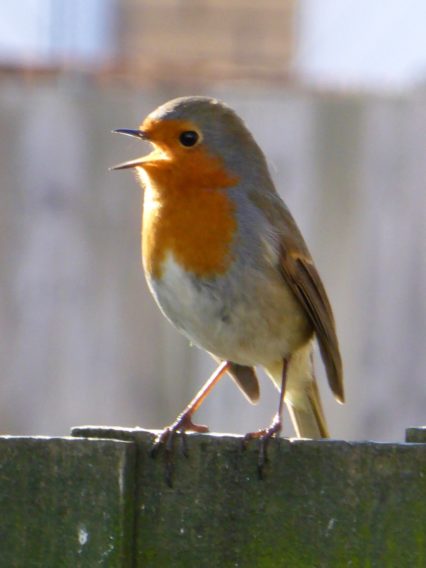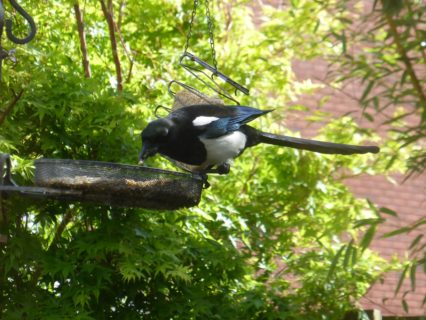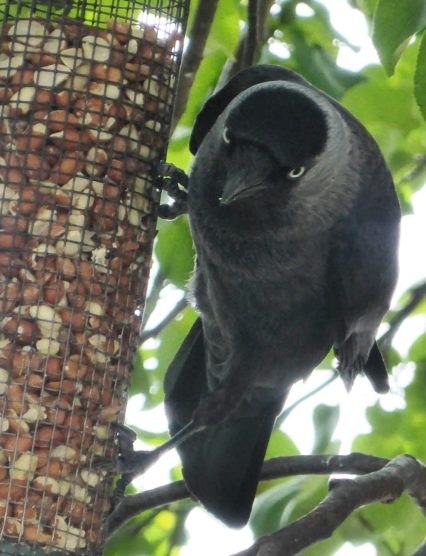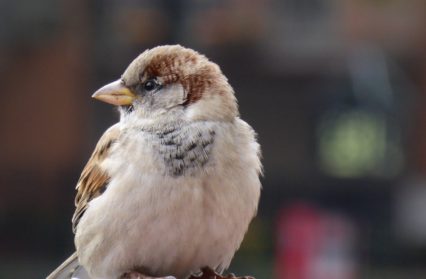Architect Richard Porch ponders on the effects of noise and light on the city’s birds.
In that dark, grey time before the day begins and the sky is the colour of an old bruise on a dead tramp’s thigh, there is a misbegotten period when only the earliest of early birds begins a chorus that shrilly proves they survived another cold night and can live for another day.
 As I lie there, about 4.00am in the morning, an amazing sonic landscape floats up out of the forbidding darkness to belie the idea it is sullenly empty or filled with stalking predators. What can be no more than a couple of handfuls of birds of unknown species are making a noise that sounds alternately like the musicians at an avant-garde music concert tuning up, or someone searching in vain for Hilversum on an old valve radio…and not finding it. Occasionally, very occasionally, the tweeting will coincide with a car alarm going off and a strange hybrid unison is achieved. When this happens the car alarm provides a mechanistic rhythm underpinning the looser, freeform birdsong, which simultaneously penetrates and ornaments the moronic freep-freep of the alarm to a pleasing degree. The two sets of sounds do not overlap or dovetail with each other, but rather achieve a kind of complementary chaos that is at once unexpected and oddly satisfying.
As I lie there, about 4.00am in the morning, an amazing sonic landscape floats up out of the forbidding darkness to belie the idea it is sullenly empty or filled with stalking predators. What can be no more than a couple of handfuls of birds of unknown species are making a noise that sounds alternately like the musicians at an avant-garde music concert tuning up, or someone searching in vain for Hilversum on an old valve radio…and not finding it. Occasionally, very occasionally, the tweeting will coincide with a car alarm going off and a strange hybrid unison is achieved. When this happens the car alarm provides a mechanistic rhythm underpinning the looser, freeform birdsong, which simultaneously penetrates and ornaments the moronic freep-freep of the alarm to a pleasing degree. The two sets of sounds do not overlap or dovetail with each other, but rather achieve a kind of complementary chaos that is at once unexpected and oddly satisfying.
Now, I am very far from being ‘a twitcher’ (a serious birdwatcher) merely an enthusiast for all forms of wildlife to be found within an urban setting. So I cannot tell you what was making the various tweeting, piping and warbling sounds. Even finding equivalents for what sound they are making is difficult even allowing for the use of onomatopoeia. My wife is sure that at least one of them was (appropriately enough) a Song Thrush, but that is about it. I honestly do not know whether it matters that much, knowing wouldn’t increase my enjoyment of it, that’s for sure. I do know that it was engaging and a delight. Part of it was, I’m sure, the thought of some tiny winged mammal, an improbably distant relative of the dinosaurs, weighing only a few ounces and only destined to live for a fleeting 12 months or so, which gave the experience an extra subliminal poignancy. That said, the sound was not plaintive nor pity-inducing. It was (at least in part) a melodic and defiant cry announcing that ‘here I am still’ or ‘stay off my patch’ depending on what the bird was trying to achieve. The notes were of pure abstract sound in sequences and rhythms I will never understand but which I find I can persuade myself were some kind of music and therefore worth appreciating.
When I say ‘some kind of music’, I mean something a bit like Steve Reich or Philip Glass, nothing too trying or in any way raucous like John Cage or Stockhausen. Although such is the worldwide variety of birdsong that you can find exotic foreign equivalents that sound shrilly mechanical and even electronic. Alas, no-one has found one yet that sounds like the soft hum of a heavy-duty electrical transformer or muffled piano keys being bashed randomly. The stuff I was listening to was repetitive yet fluid and alterations to the timing of each burst of song somehow turned what should have been a random cacophony into an ensemble piece. It is not music of course; merely an animal making the only noise it can make as it stakes out its territory or whatever. Interestingly research tells us that birds learn to ‘sing’; they do not do it automatically. Deaf birds cannot sing at all. I wonder how many birds died in some laboratory to enable that statement to be made.
 That birds sing at all is hugely to be admired. They do so frequently in the face of enormous odds. During the autumn I watched some birds battle a day of high winds. Some took refuge in trees bending quiescently in near gale-force conditions. The birds were Sparrows and I saw them take off using short looping bursts of flight designed to gain them a nearby rooftop. I don’t know what the collective noun is for a flight (is that one?) of Sparrows is, but it was fascinating to see their progress halted by a gust of wind which hit them and ushered them off in another direction. The wind was like an invisible hand that blocked their progress and physically pushed them along another route.
That birds sing at all is hugely to be admired. They do so frequently in the face of enormous odds. During the autumn I watched some birds battle a day of high winds. Some took refuge in trees bending quiescently in near gale-force conditions. The birds were Sparrows and I saw them take off using short looping bursts of flight designed to gain them a nearby rooftop. I don’t know what the collective noun is for a flight (is that one?) of Sparrows is, but it was fascinating to see their progress halted by a gust of wind which hit them and ushered them off in another direction. The wind was like an invisible hand that blocked their progress and physically pushed them along another route.
Meanwhile in our tiny garden, Magpies and Jackdaws foraged in small gangs all the better to intimidate smaller less group-orientated birds. Jackdaws in particular are good at crowding out competitors for food. They merely arrive in numbers and gang up on solitary eaters forcing them to fly off for fear of physical attack. Magpies and Jackdaws are bigger propositions as garden birds go and do not have the laughably spindly legs of say a Robin. The latter’s look as though they are made from thin gauge plastic rod and end in four-toed claws, which are a comical counterpoint to the fluffy rotundity of the birds feathered body. Whereas the Corvid species (Jackdaws, Magpies, Rooks and Crows, etc.) have those wrinkly black legs that look like the old gaiters of a Victorian parson and are a whole order thicker than a Robin’s. Not the same as a chicken but about the same thickness as a pipe-cleaner and leathery, ending in sharp claws that 160 million years ago would have torn the living flesh off bones when the bird was a carnivorous dinosaur.
Nowadays the bigger garden birds confine themselves to raiding the nests of other birds and devouring the chicks or eating cat food left out for a neighbour’s pet. I’ve watched a Magpie wait patiently behind a cat, at a distance of no more than twelve inches, for its turn to eat any scraps left. They are by some way the noisiest and most prolific garden birds too. They have a throaty croak and when alarmed make a noise exactly like an old wooden football rattle being rung. Onomatopoeically it is a repetitive clack-clack-clack at high volume and with a harsh tone. They use it to warn of predators; in a suburban garden setting this means cats or if humans are around. They can also make cackling and tutting sounds; the latter does not sound like a bird at all and more like the vocalisation that some sort of pensive reptile might make.
Indeed, I have always thought that Magpies were the garden bird still most like the dinosaurs that all birds evolved from. It is easy to mentally subtract the Magpie of its plumage and imagine it instead with the leathery skin of some small but predatory reptile. I can easily imagine it as a two-footed lizard with feathers and a tapered balancing tail covered in a down of brightly coloured feathers. It soon looks like some later evolution of Archaeopteryx, the early bird-reptile. Magpie’s are aggressive and will drive off other birds from food sources. Their black and white colouring seemingly offers little in the way of camouflage (in reality the black plumage has the iridescent sheen of a Starling) and the black feathers that cover the bird’s head finish in a curved arc across its breast as if it is wearing a hood. How did that curve evolve? Its two-tone feathers should not be a good arrangement for hiding against the organic ochres and greens to be found in the average garden. This is an odd quirk of nature, given that a strong outline is the enemy of successful camouflage. The distinctive German ‘Stahlhelm’ or ‘Coalscuttle’ helmets of World War 2 had to be netted to carry twigs and leaves to disguise their distinctive shape. In the First and Second World Wars, the hulls of ships were painted in dramatically colourful and geometric ‘dazzle patterns’ to obscure their outline and confuse submarines attempting to torpedo them. Recently, climate protestors painted their faces in similar jazz-age geometric shapes, in an attempt to thwart facial-recognition technology being employed by the police. Perhaps it is precisely the combination of the Magpie’s harsh vocalisations and its uncompromising two-tone plumage that warns avian competitors of the creature’s aggressive nature, who knows?
 Near to where I live there is a ‘clattering’ of Jackdaws, which is the collective noun for a gathering of this smallest of the Corvid species. By far the least sinister looking of the three, Jackdaws nevertheless retain a funereal appearance that is only slightly mitigated by them having eyes the colour of blue ice. A far more social proposition than the Magpie, it flies in volatile black clouds containing many dozens of birds. When in flight they emit a loud and throaty ululation or cackle type of call that, via Doppler effect, can sound alternately like a cheap car alarm or (when closer) something altogether more Hitchcockian and Gothic. The sort of sound that one imagines a vampire bat with a hangover might make. Experienced en masse it can send cats out looking for a big, juicy garden bird for their supper scurrying for the cover of home. Jackdaws roost at night in tall trees in their hundreds, and if disturbed by a prowling cat will set up a din that functions as an alarm call to all its collective members. They will then take off and perform a few noisy circuits around where they are roosting, as if to make sure that everyone else is awake too, before settling down again.
Near to where I live there is a ‘clattering’ of Jackdaws, which is the collective noun for a gathering of this smallest of the Corvid species. By far the least sinister looking of the three, Jackdaws nevertheless retain a funereal appearance that is only slightly mitigated by them having eyes the colour of blue ice. A far more social proposition than the Magpie, it flies in volatile black clouds containing many dozens of birds. When in flight they emit a loud and throaty ululation or cackle type of call that, via Doppler effect, can sound alternately like a cheap car alarm or (when closer) something altogether more Hitchcockian and Gothic. The sort of sound that one imagines a vampire bat with a hangover might make. Experienced en masse it can send cats out looking for a big, juicy garden bird for their supper scurrying for the cover of home. Jackdaws roost at night in tall trees in their hundreds, and if disturbed by a prowling cat will set up a din that functions as an alarm call to all its collective members. They will then take off and perform a few noisy circuits around where they are roosting, as if to make sure that everyone else is awake too, before settling down again.
Modern streetlighting affects birdsong too. It can convince birds that it is still daylight when the surrounding dark has been gathering on a winter’s evening since 4.00pm. I regularly hear the repetitive dip-dip-dip of some poor deluded Robin late on a winter’s night still singing its little heart out beneath a streetlamp. A heart that beats at a thousand beats a minute in the simile-ridden dark beyond my study window.
Unlike most, I was aware of the music that birds make before the Coronavirus pandemic silenced our towns and cities. Before long it will disappear back into the background noise of car alarms, vehicle engine noise and the rest. Appreciate it until the next pandemic arrives.
(All images captured by the author)












